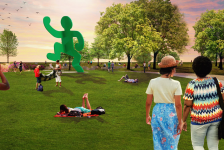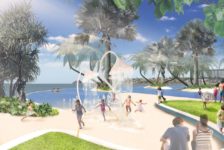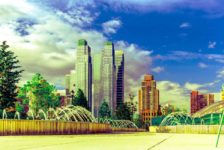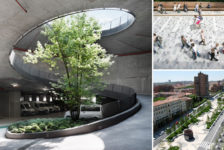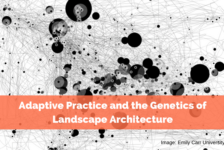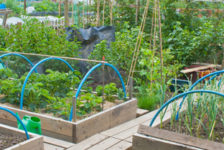Bill and Melinda Gates Foundation Project, Gustafson Guthrie Nichol, Seattle, USA “What does it take to change the world? How can each of us make a difference?” This bold question that stretches across the home page of the Bill and Melinda Gates Foundation website sounds as ambitious and inspirational as the design of the foundation’s headquarters. The couple’s vision of creating a permanent home for their international humanitarian organization came to fruition when they combined the foundation’s five separate locations into one in spring 2011. It is often said that we first need to help ourselves before we can help the world; at this campus, the “Gates family” of staff and partners works together in this beautiful, comfortable, and stimulating outdoor-indoor environment to help others around the world also get a chance to live healthy and productive lives.
The headquarters is a LEED platinum campus, reflecting how intrinsic values can be carried forward into physical design implementations. Let’s dive deeper to see why this project is not just a pretty picture. What inspired this project? When first imagining their campus design, architects at the Seattle-based firm NBBJ were inspired by a map of the globe that illustrated the pathways and connection of world travel and commerce. The designers then mapped out pathways of their own, originating from a point in Seattle to places around the globe where the foundation is working to improve the health and infrastructure of the world’s most vulnerable people in 100 countries. These initial drawings developed into the outward reaching “arms” of the campus buildings. Conceptually, the idea connects the foundation to its global work. But the arms are grounded in Seattle, resting on buildings that align within the city’s street grid. Working alongside NBBJ, which designed the buildings, Gustafson Guthrie Nichol designed the campus landscape to be an outdoor working environment that stimulates collaboration and problem solving.Low-impact, Sustainable Design
The concept for the space grew out of long-term thinking. The foundation wanted to create a sustainable, low-impact campus built to last 100 years, instead of the typical 20- to 30-year timeline envisioned for typical office space projects. From the beginning, the foundation wanted a space that functioned as an outdoor work environment, so that workers could be informed and inspired by nature and the outside world.
The landscape format reinforces street edges and aligns campus features — from pathways to water edges — with the surrounding streets and buildings. The materials and functions of the landscape are informed by the area’s natural history as a wetland marsh. The Gates Foundation campus incorporates the native landscape, local materials, natural processes, and an integrated sustainable system that includes harvesting rainwater, reducing potable water consumption, maximizing solar energy use, and minimizing energy use. No water wasted Water conservation was a guiding principle of the project. The vision for the campus was to enhance the local watershed by restoring habitat, improving stormwater management, and reducing the office space’s demand for potable water. Two acres of green roof meets this need by absorbing and processing as much as 90 percent of rainwater received. The remaining hardscape runoff and rooftop drainage is collected in a rainwater storage tank. The rainwater-fed central pool contains native aquatic plants, including reeds and cattails. A one-million-gallon cistern beneath the complex holds and processes rainwater from building roofs, feeds the water feature, and fulfills irrigation needs and toilet flushing in campus buildings. The cistern reduces the campus’ potable water needs by 80 percent. Related Articles:- 1315 Peachtree Street
- 10 Practices Showing That “Sustainability” is More Than Just a Buzzword!
- Lotus Lake Park Sets Precedent for Sustainable Urban Design in China
Purposeful pallet The materials and functions of the landscape are informed by the site’s natural history as a dark-watered bog that absorbed and filtered rainwater. The wooden boardwalk circulation includes seating over the water garden, designed to maximize opportunities for outdoor meetings.
The Gates Foundation wanted the outdoor areas to be an extension of the indoor meeting and office space, available for collaboration and problem solving. The Campus Heart Plaza includes moveable outdoor seating and Big Leaf maples to provide shade. The plantings mix native species such as vines and maples, including edible plants such as blueberries, to line the entrance, as well as using non-invasive, drought-tolerant plants. “Local Ground, Global Vision” The campus was designed to bring life and nature to its location in an urban neighborhood in Seattle. Wooden street furniture integrates the campus with the sidewalks of 5th Avenue, lined by plantings to create space between the office space and the street. Locals often wait for the bus on benches at the edge of the complex. The campus is the result of an integrated team of designers, engineers, and contractors who were guided by long-term thinking and the foundation’s overall philosophy of respecting our existing environment and the neighborhood. It has led to a design with welcoming arms — in both an environmental and social sense. The lasting sustainability of the campus is meant to provide the best possible space for foundation staff to do their best work, and the thoughtfulness and the integrity of the final outcome is undeniable. After all, wouldn’t you like to work in an office space that really takes into account the wellbeing of the workers and the environment? Recommended Reading:- Principles of Ecological Landscape Design by Travis Beck
- Design with Nature by Ian L. McHarg
Article written by Win Phyo Return to Homepage
Published in Blog













